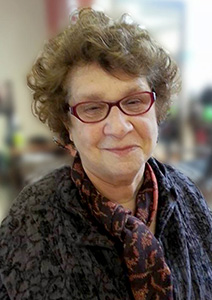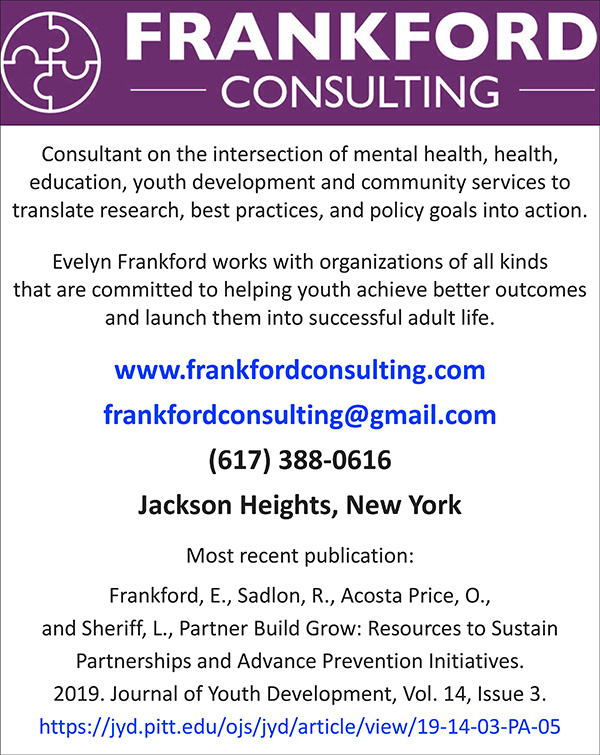Over recent decades, late adolescence and young adulthood, generally the years 16 or 18 through 25, have emerged as a distinct developmental period in the human life span. In the mental health field, the term Transition Age Youth and Young Adults – TAYYA – has come to describe young people of this age group who experience serious mental health challenges.

Evelyn R. Frankford, MSW
Such mental health problems represent the largest burden of disease in these young people. In 2014, the 18-25 age group had one of the highest proportions of serious mental illness (SMI), at 4.8% (HHS, 2016).
The practical implication of the disease trajectory means that more than 50% of students aged 14 or older with a mental health condition drop out of high school, the highest dropout rate of any disability group. Such students also experience low grade point averages, poor attendance, and the highest expulsion/suspension rates among all students with disabilities (Alikhan, S. et al., 2016, Psychiatry Information in Brief, 13(9). Worcester, MA: University of Massachusetts Medical School, Department of Psychiatry).
The situation is complex, and the remedy is not to provide more services of the kind that have been traditionally available. Rather, what’s needed is innovation in special education and supportive services to focus on changing the environment in which TAYYA live their lives, i.e., to impact the social determinants that add distress to whatever psychiatric illness they may have.
Education is a Social Determinant
Social determinants, i.e., the environmental, physical, and economic conditions in which one lives, works, learns, and plays, are strong predictors of child outcomes, including general health and education. Unfortunately, of American children from birth to age 17, more than 45% have had at least one parent-reported adverse childhood experience, such as the death of a parent, witnessing abuse in the home, food scarcity or homelessness, living with someone who abused drugs or alcohol, or being exposed to violence. More than half of all U.S. public school children receive free and reduced-price lunch, a frequent proxy for communities experiencing high levels of poverty, signaling a need to acknowledge poverty’s many associated social and economic challenges (Citations in Frankford, E., et. al.).
The 2020 COVID-19 pandemic and its attendant financial upheaval, combined, after the murder of George Floyd, with renewed focus on long-standing racial injustice and associated trauma in the U.S., highlight how social determinants undermine mental health and crimp educational opportunity for many young people. According to the Centers for Disease Control and Prevention (CDC), long-standing systemic health and social inequities have put many people from racial and ethnic minority groups at increased risk of getting sick and dying from COVID-19. For example, the CDC notes specifically that inequities in access to high-quality education for some racial and ethnic minority groups can lead to lower high school completion rates and barriers to college entrance. This may limit future job options and lead to lower paying or less stable jobs. People with limited job options likely have less flexibility to leave jobs that may put them at a higher risk of exposure to the virus that causes COVID-19. People in these situations often cannot afford to miss work, even if they’re sick, because they do not have enough money saved up for essential items like food and other important living needs (https://www.cdc.gov/coronavirus/2019-ncov/community/health-equity/race-ethnicity.html).
Changing the School Environment
These social inequities impair opportunities for many TAYYA. Current expulsion/suspension rates disproportionately impact young Black males with disabilities, who are 50-75% more likely to be suspended than other students. According to studies, even one suspension increases the likelihood of dropping out and repeated suspension increases that likelihood (Balfanz, Byrnes & Fox, 2012). In Westchester County (New York), for example, Black children constitute 14% of the student population but 23% of dropouts and 41% of suspensions (Lake, A., Westchester Children’s Association, Anti-Racist Alliance Forum, September 21, 2020). For special education students with behavioral challenges, these percentages are no doubt higher.
Schools represent an important context that wields long-term influence on child cognitive and social development (Atkins, Hoagwood, Kutash, & Seidman, 2010, in Frankford, Op. Cit.). For students with serious behavioral challenges, the formative periods of childhood and adolescence are an optimal time for mitigating the impact of adverse social determinants, inequities, and trauma. Special educators, teachers, school administrators, and youth program directors and workers, are on the front lines, observing behaviors and situations exacerbated by social conditions beyond any one individual’s control, yet able to buffer some effects of their environments.
Given the disproportionate percentage of youth of color in special education programs for behavioral and emotional challenges, school and community mental health partners must pivot to increase graduation rates of such students through an equity focus in programming and positive engagement with young people. Instead of symptom management, “mental health interventions” must work with students to complete high school, preferably with some Career and Technical Education credits, to enable getting a satisfying job. Research has shown that getting and keeping employment is a protective mental health factor for such young adults.
Interrupting the School to Prison Pipeline
Getting on a track to a satisfying job can interrupt and prevent the school to prison pipeline by diminishing expulsions and suspensions and by diverting youth from entry into the carceral system. School interventions that confront harmful social determinants and mitigate their impact include: authorizing youth to direct their own IEPs, incorporating restorative justice practices, implementing Social and Emotional Learning (SEL) curricula, and deploying a relationship-based positive youth development approach to coach youth and engage them in discovery-oriented pursuits.
A Working Group anchored in the Peekskill City School District, with involvement of the Westchester County Department of Community Mental Health and SUNY-Albany School of Education, is working to launch just such a special education program for TAYYA with serious behavioral health challenges. The initiative aims to change the typical impact of social determinants that divert youth from life-saving, mental health-promoting education by transforming the Transition feature of special education Individual Education Plans (IEPs) (https://escholarship.umassmed.edu/cgi/viewcontent.cgi?article=1151&context=pib).
This is what the anticipated success for youth participants will look like:
- Providing direction to their own IEPs
- Graduating from high school
- Participating in Career and Technical Education (CTE) courses in high school and transitioning to community college or other post-secondary courses where the young person can obtain a credential in a field of interest
- Participating in community endeavors, possibly with local businesses
- Assisting evaluator/researchers by using their technology skills with regard to data
- Improvement in their own self-perception and of their efficacy in managing life tasks
Social determinants have always undermined the success of most adolescents and young adults with serious mental health conditions. Add to these historic factors COVID-19, which is setting back a whole generation of students. Students of color and those in special education will be primary victims of the loss of in-person schooling. To use our President-Elect’s slogan: Build Back Better should focus our mental health agenda. Building back better means changing the environments in which our youth and young adults with serious mental health conditions go to school and prepare for their futures. Doing so is both urgent and possible.
Evelyn R. Frankford, MSW, is a consultant working with transition-age youth and young adults at Frankford Consulting in Jackson Heights, NY. In conjunction with partners in the Peekskill City School District Special Education reform initiative: Dr. Tammy Ellis-Robinson, Assistant Professor of Special Education at SUNY-Albany; Patricia White, MPA, Consultant with Westchester County Department of Community Mental Health; Dr. Margie Daniels and Ellen Gerace, MSW, Peekskill City School District.
The article from which several citations are taken is: Frankford, E., Sadlon, R., Acosta Price, O., and Sheriff, L., Partner Build Grow: Resources to Sustain Partnerships and Advance Prevention Initiatives. 2019. Journal of Youth Development, Vol. 14, Issue 3. https://jyd.pitt.edu/ojs/jyd/article/view/19-14-03-PA-05.




